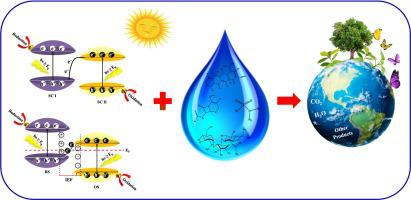FlatChem ( IF 6.2 ) Pub Date : 2023-12-09 , DOI: 10.1016/j.flatc.2023.100597 Paria Hemmati-Eslamlu , Aziz Habibi-Yangjeh

|
With the striking release of antibiotic wastewater into the aqueous environments, currently, antibiotic contaminations have become a drastic worldwide issue. To alleviate this issue, diverse studies on the degradation and elimination of these highly stable recalcitrant compounds are carried out. In this respect, heterogeneous photocatalysis has attracted notable consideration of research communities, because of its promising potential to eliminate these pollutants from aquatic environments through an economical, green, and efficacious procedure. As a metal-free photocatalyst, g-C3N4 has inspired enormous consideration owing to its extraordinary characteristics. Nonetheless, the finite visible-light harvesting amount, quick recombination of charges, insignificant oxidation power, and poor textural attributes are the crucial disadvantages of g-C3N4, limiting its photocatalytic ability. These obstacles can be impressively resolved through the fabrication of g-C3N4-based heterojunction systems with semiconductors having proper energy bands. Till now, various semiconductors have been utilized to develop Z- and S-scheme systems by g-C3N4. Accordingly, this review summarizes lately developed impressive photocatalysts fabricated by anchoring g-C3N4 with various semiconductors through Z- and S-scheme structures for the photocatalytic degradation of various antibiotics. Ultimately, several perspectives on the future progress and challenges in the arena of photocatalytic elimination of antibiotics over promising photocatalysts are represented.
中文翻译:

由 g-C3N4 组成的令人印象深刻的 Z 型和 S 型光催化剂用于抗生素解毒的综述
随着抗生素废水大量释放到水环境中,目前,抗生素污染已成为一个严重的世界性问题。为了缓解这个问题,对这些高度稳定的顽固化合物的降解和消除进行了多种研究。在这方面,多相光催化因其通过经济、绿色和有效的程序消除水生环境中这些污染物的巨大潜力而引起了研究界的广泛关注。作为一种非金属光催化剂,gC 3 N 4因其非凡的特性而引起了广泛的关注。然而,有限的可见光捕获量、快速的电荷重组、微弱的氧化能力和较差的结构属性是gC 3 N 4的关键缺点,限制了其光催化能力。通过使用具有适当能带的半导体制造基于gC 3 N 4的异质结系统,可以令人印象深刻地解决这些障碍。迄今为止,各种半导体已被用于通过gC 3 N 4开发Z型和S型系统。因此,这篇综述总结了最近开发的令人印象深刻的光催化剂,通过 Z 型和 S 型结构将 gC 3 N 4与各种半导体锚定,用于光催化降解各种抗生素。最后,对光催化消除抗生素领域相对于有前景的光催化剂的未来进展和挑战提出了几种观点。



























 京公网安备 11010802027423号
京公网安备 11010802027423号